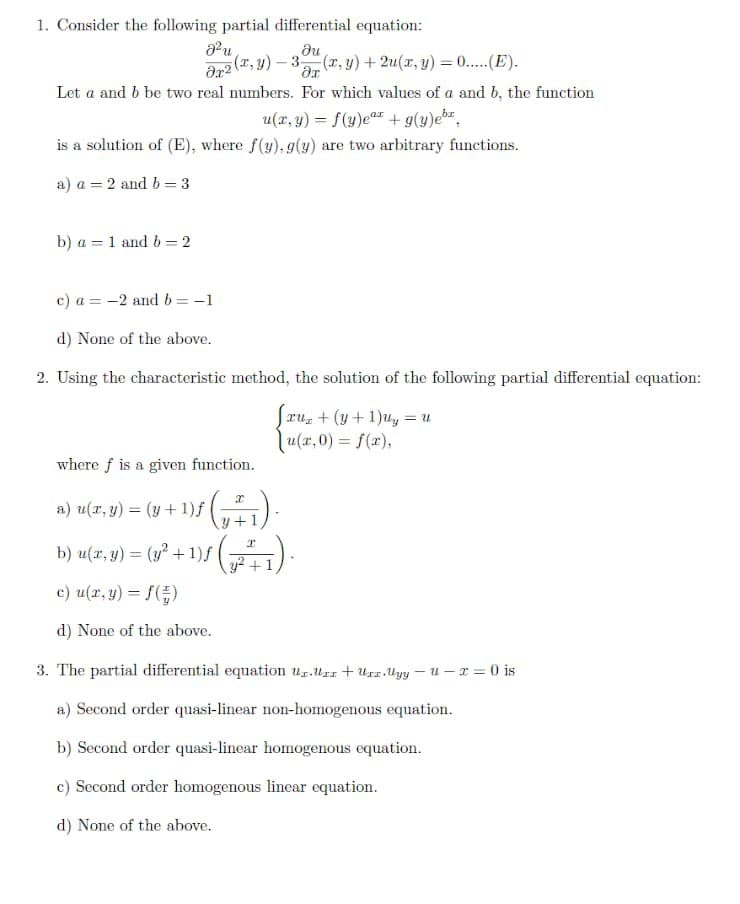1. Consider the following partial differential equation: du ar2 (r, y) – 3(x, y) + 2u(x, y) = 0....(E). Let a and b be two real numbers. For which values of a and b, the function u(r, y) = f(y)eas + g(y)ebz is a solution of (E), where f(y), g(y) are two arbitrary functions. a) a = 2 and b= 3 b) a = 1 and b = 2 c) a = -2 and b = -1 d) None of the above,
1. Consider the following partial differential equation: du ar2 (r, y) – 3(x, y) + 2u(x, y) = 0....(E). Let a and b be two real numbers. For which values of a and b, the function u(r, y) = f(y)eas + g(y)ebz is a solution of (E), where f(y), g(y) are two arbitrary functions. a) a = 2 and b= 3 b) a = 1 and b = 2 c) a = -2 and b = -1 d) None of the above,
Advanced Engineering Mathematics
10th Edition
ISBN:9780470458365
Author:Erwin Kreyszig
Publisher:Erwin Kreyszig
Chapter2: Second-order Linear Odes
Section: Chapter Questions
Problem 1RQ
Related questions
Question

Transcribed Image Text:1. Consider the following partial differential equation:
du
(T,y) -3 (r, y) + 2u(r, y) = 0....(E).
Let a and b be two real numbers. For which values of a and b, the function
u(x, y) = f(y)ear + g(y)eb"
is a solution of (E), where f(y), g(y) are two arbitrary functions.
a) a = 2 and b = 3
b) a = 1 and b= 2
c) a = -2 and b = -1
d) None of the above.
2. Using the characteristic method, the solution of the following partial differential equation:
|ru + (y+1)uy = u
|u(x,0) = f(x),
%3D
where f is a given function.
a) u(r, y) = (y + 1)f (
b) u(x, y) = (y² + 1)f( ).
c) u(r, y) = f()
d) None of the above.
3. The partial differential equation uz.Urr+ Urr.Uyy – u -r = 0 is
a) Second order quasi-linear non-homogenous equation.
b) Second order quasi-linear homogenous equation.
c) Second order homogenous linear equation.
d) None of the above.
Expert Solution
This question has been solved!
Explore an expertly crafted, step-by-step solution for a thorough understanding of key concepts.
Step by step
Solved in 3 steps with 2 images

Recommended textbooks for you

Advanced Engineering Mathematics
Advanced Math
ISBN:
9780470458365
Author:
Erwin Kreyszig
Publisher:
Wiley, John & Sons, Incorporated

Numerical Methods for Engineers
Advanced Math
ISBN:
9780073397924
Author:
Steven C. Chapra Dr., Raymond P. Canale
Publisher:
McGraw-Hill Education

Introductory Mathematics for Engineering Applicat…
Advanced Math
ISBN:
9781118141809
Author:
Nathan Klingbeil
Publisher:
WILEY

Advanced Engineering Mathematics
Advanced Math
ISBN:
9780470458365
Author:
Erwin Kreyszig
Publisher:
Wiley, John & Sons, Incorporated

Numerical Methods for Engineers
Advanced Math
ISBN:
9780073397924
Author:
Steven C. Chapra Dr., Raymond P. Canale
Publisher:
McGraw-Hill Education

Introductory Mathematics for Engineering Applicat…
Advanced Math
ISBN:
9781118141809
Author:
Nathan Klingbeil
Publisher:
WILEY

Mathematics For Machine Technology
Advanced Math
ISBN:
9781337798310
Author:
Peterson, John.
Publisher:
Cengage Learning,

